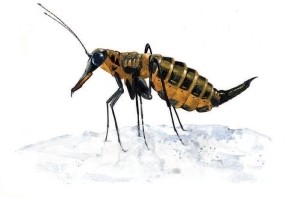
While pursuing iNaturalist records of insects in the Saint Michael's College Natural Area, I noticed a species I had never encountered, and it was recorded at an unusual time of the year for terrestrial insects. Late November, however, turned out to be the perfect time for the insect in question.
A bit larger than a housefly, snow scorpionflies walk and even jump substantial distances on snow. When most other invertebrates have gone dormant, snow scorpionflies are out and about looking for food and, of course, romance – or at least mating opportunities. Two species occur in New England: the Midwinter Boreus (Boreus brumalis) and Snow-born Boreus (Boreus nivoriundus).
Despite the scorpionfly moniker, these insects are not true flies (order Diptera) and bear only a passing resemblance to scorpions. They are placed in the order Mecoptera along with hangflies. Recent research suggests that snow scorpionflies are more closely related to fleas than to other scorpionflies, which may explain the lateral flattening that they have in common with fleas. The “snow” part of their name is well earned and requires some particular adaptations.
Warming tiny muscles for winter movement is a balancing act between heat loss and gain. Grade-school students learn that heat moves by conduction, convection, and radiation; managing all three is essential for winter insects. Gerard Courtin of Laurentian University carefully measured heat gained by snow scorpionflies from short-wave solar radiation and from longer-wave energy radiating from sun-warmed surfaces, along with cold air movement that might conspire to strip heat in the same way that wind chill affects us all.
According to Courtin, scorpionflies achieve near miraculous thermal efficiency by absorbing solar radiation through their dark cuticles, and by remaining in the boundary layer, close to the snow, where convective airflow is slowest and wind chill is least. The snow actually increases thermal gains by reflecting solar heat back up at the insects.
One final trick helps snow scorpionflies hang on to precious heat: their lanky legs keep them above the snow where contact would rapidly conduct heat away. Instead of resting on the substrate as many insects do, a snow scorpionfly’s grip on the snowy surface is reduced to six tiny points of contact: one at the end of each leg.
These adaptations keep the insect’s body temperature as much as six degrees warmer than ambient air – warm enough to scramble across snow. But warm enough to walk and hop is not quite warm enough to fly. Insect flight requires rapidly twitching muscles that can’t be sustained at very cold temperatures.
For this reason, scorpionflies have, during countless generations, reduced their wings substantially. The females have stubby wings that do not have a function yet discerned; but male wings are essential for the existence of the species. During copulation, the male cradles the female on his back in the embrace of his strap-like wings, while managing to hold his stilted pose above the snow surface.
I want to find some snow scorpionflies this winter, so I went back to iNaturalist to look for patterns in timing. As I broadened my search to the entire state of Vermont, the information I found was less about scorpionflies and more about observers of the curious insects. One observer, Erica Mitchell, has logged more scorpionflies than all others combined: 20 of the 32 New England records. In fact, she seems to have the most Boreus observations on the planet.
I contacted Mitchell to see if I could learn some of her tricks to detecting these elusive insects. Her advice was simple: “Don’t be afraid of the snow. Don’t assume that there’s nothing there.” As a skier and an occasional snowshoer, I’m out in all kinds of weather. Although I often see spiders, snowfleas, and winter stoneflies, scorpionflies have thus far eluded me. So I pressed for more details, and she revealed her newfound sport of searching for invertebrates on snow. She makes a regular habit of traversing a two-mile route near her Vermont home to document snow-traveling insects, spiders, and other cold-loving organisms. Mitchell’s most productive trips happen after or even during fresh snowfall. She told me that before twigs, leaf scraps, and conifer cone scales have speckled the pristine snow, it’s easier to detect the slow movement of spiders, springtails, winter craneflies, and, of course, snow scorpionflies.
With all this information in mind, I feel ready to detect the golden metallic luster of the Mid-winter Boreus, or the Snow-born Boreus’s chestnut-brown exoskeleton standing out from woodland snows this winter. If you decide to join the quest, Erica Mitchell suggests trying the shoulders of the season rather than the true depth of winter. She advises picking warmer days, when the snow surface has warmed just shy of melting. I’ll be looking for your observations on iNaturalist!


Discussion *